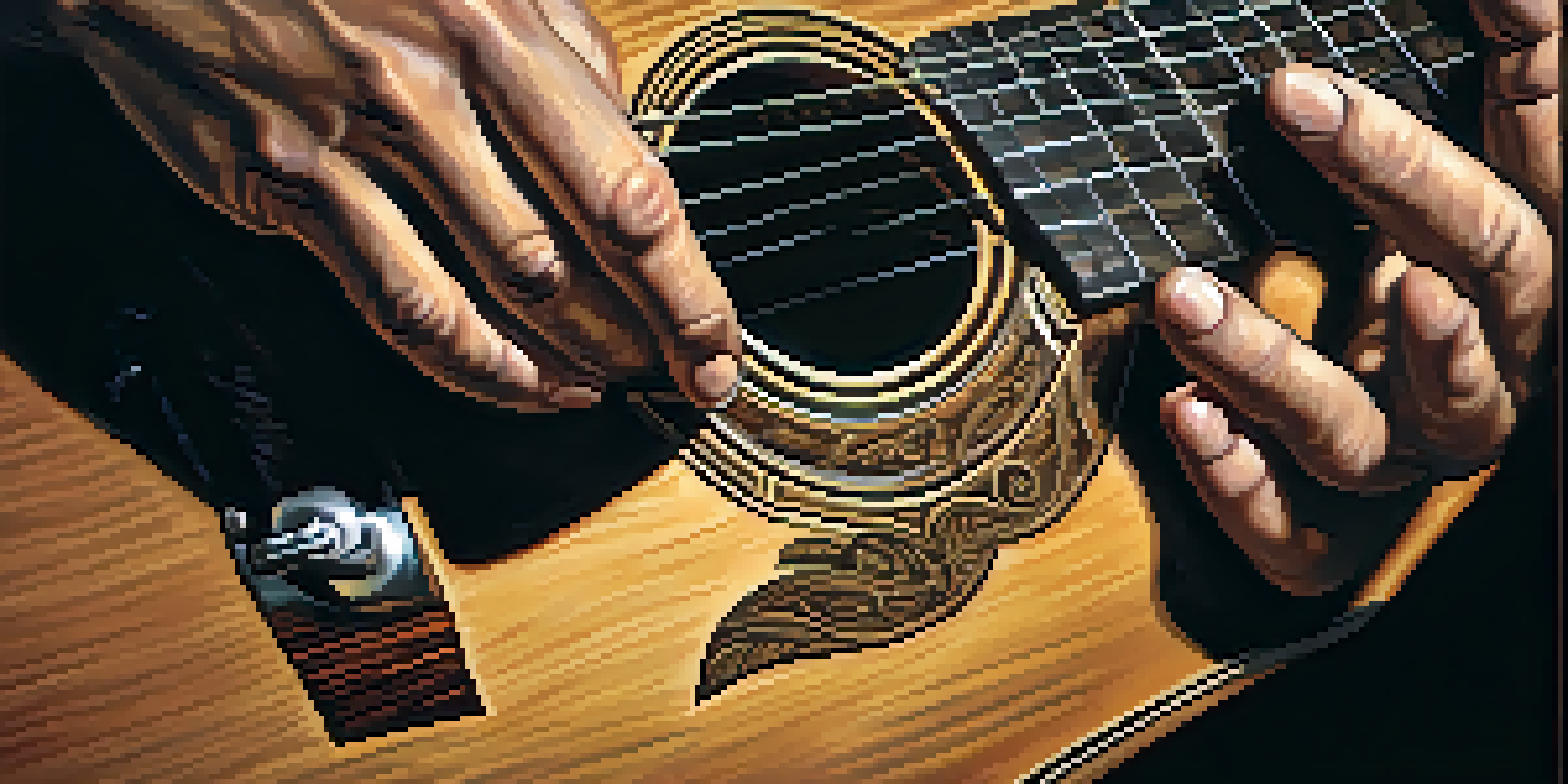Fingerstyle Techniques for Accompanying Vocals on Guitar

Understanding Fingerstyle Basics for Guitar
Fingerstyle guitar is a technique that allows you to play multiple musical lines simultaneously. Unlike strumming, where you use a pick to hit chords, fingerstyle involves plucking the strings with your fingers. This method is particularly effective for accompanying vocals, as it adds depth and texture to the music without overshadowing the singer.
The guitar is a miniature orchestra in itself.
At its core, fingerstyle is about control and precision. You can use your thumb for the bass notes and your fingers for the melody, creating a harmonic balance. This technique can be likened to a conversation, where each instrument and voice has its distinct role, yet they all contribute to a harmonious dialogue.
As you dive into fingerstyle, you'll discover various patterns and styles that suit different genres. Whether you're playing folk, blues, or pop, understanding the basics will set a solid foundation for your accompanying skills.
Choosing the Right Fingerstyle Patterns
Picking the right fingerstyle pattern is crucial for complementing vocals. Some patterns are straightforward, while others may require more intricate finger movements. A common beginner pattern is the Travis picking style, which alternates bass notes with melody notes, creating a flowing rhythm that supports the voice beautifully.

Experimenting with different patterns can lead to discovering what works best for the song and the singer's vocal style. For instance, a syncopated rhythm can add energy to an upbeat song, while a gentle arpeggio might suit a ballad. Think of these patterns as spices in cooking; the right combination can enhance the dish without overpowering it.
Master Fingerstyle Basics
Understanding fingerstyle guitar techniques enhances your ability to create rich, supportive melodies that accompany vocals.
Listening to various artists can inspire your choice of patterns. Notice how they adapt their fingerstyle techniques to fit the mood and lyrics of the song, and try to incorporate those ideas into your playing.
Creating a Supportive Harmony for Vocals
One of the primary goals when using fingerstyle techniques is to create a supportive harmony for the vocals. This means playing chords and melodies that enhance the singer's performance without distracting from it. A good rule of thumb is to stay within the chord structure of the song, allowing the vocals to shine.
Music is the shorthand of emotion.
Using open chords can add a rich, resonant sound to your accompaniment. By allowing some strings to ring out, you create a fuller sound that can envelop the vocalist. Picture it like a gentle wave, lifting the voice without overtaking it, making the combination feel natural and cohesive.
As you develop your fingerstyle technique, focus on the dynamics of your playing. Softening your touch during vocal sections and subtly increasing volume during instrumental breaks can create an engaging contrast that keeps listeners interested.
Incorporating Melodic Elements into Your Playing
Incorporating melodic elements into your fingerstyle technique can elevate the overall performance. Adding simple melodies between vocal lines can draw attention to key phrases and make the song more memorable. This technique can be especially effective in folk and acoustic genres.
Think of your fingerstyle guitar as an extension of the vocalist's voice. For example, if the singer holds a note, you might play a complementary melody that resonates with that emotion. This approach not only enriches the arrangement but also creates a dynamic interplay between voice and instrument.
Choose Patterns Wisely
Selecting the right fingerstyle patterns is crucial for complementing vocals and enhancing the overall performance.
When experimenting with melodies, ensure they align with the song's mood and message. A well-placed melodic phrase can enhance the storytelling aspect of the lyrics, making the performance feel more cohesive and impactful.
Using Dynamics to Enhance Vocal Performance
Dynamics play a crucial role in any musical performance, but they are especially important when accompanying vocals. By varying your fingerstyle intensity, you can create emotional highs and lows that correspond with the singer's delivery. This technique helps to build tension and release, making the performance more engaging.
For instance, during a powerful chorus, you might strum more forcefully or employ a fuller fingerstyle pattern to match the energy. Conversely, during softer verses, reducing your volume and simplifying your pattern can allow the vocals to take center stage. It's a delicate balance, akin to a dance where both partners must move in harmony.
Listening to how professional guitarists adjust their playing during live performances can provide valuable insights. Notice when they increase or decrease dynamics and how that influences the overall feel of the song.
Practicing Fingerstyle Techniques for Consistency
Consistent practice is key to mastering fingerstyle techniques. Regularly dedicating time to practice not only enhances your skill but also builds muscle memory. Start with simple exercises that focus on finger independence and coordination, which are essential for executing more complex patterns seamlessly.
As you practice, consider using a metronome to improve your timing and rhythm. Gradually increase the speed as you become more comfortable with the patterns. This method ensures that when you're accompanying vocals, your playing remains steady and reliable, allowing you to respond to the singer's nuances effortlessly.
Use Dynamics for Impact
Varying your playing dynamics can significantly elevate the emotional connection between the guitar and the singer's performance.
Additionally, recording your practice sessions can provide valuable feedback. Listening back to your playing can help you identify areas for improvement, ensuring that your fingerstyle technique is consistently polished and ready to support any vocal performance.
Finding Inspiration from Influential Fingerstyle Artists
Exploring the works of influential fingerstyle guitarists can provide a wealth of inspiration for your own playing. Artists like Tommy Emmanuel, Andy McKee, and Sungha Jung have unique styles that showcase the versatility of fingerstyle techniques. Their performances can spark creativity and motivate you to experiment with your own sound.
Listening to different genres can broaden your understanding of how fingerstyle can be applied in various contexts. Notice how these artists blend technical skill with emotional expression, creating music that resonates deeply with listeners. Try emulating their techniques and then personalizing them to fit your style.

Attending live performances, whether in person or through online platforms, can also ignite your passion for fingerstyle. Witnessing the connection between the artist and their audience can be incredibly motivating, reminding you of the joy that comes from sharing your music.